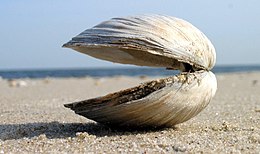
Back محار ملزمي Arabic Amasuela AST Cloïssa Catalan Gák-lì CDO Αχιβάδα Greek Almeja Spanish Txirla Basque صدف دوکفهای Persian Palourde French Breallach Irish
This article needs additional citations for verification. (November 2021) |

Clam is a common name for several kinds of bivalve mollusc. The word is often applied only to those that are edible and live as infauna, spending most of their lives halfway buried in the sand of the sea floor or riverbeds. Clams have two shells of equal size connected by two adductor muscles and have a powerful burrowing foot.[1] They live in both freshwater and marine environments; in salt water they prefer to burrow down into the mud and the turbidity of the water required varies with species and location; the greatest diversity of these is in North America.[2]
Clams in the culinary sense do not live attached to a substrate (whereas oysters and mussels do) and do not live near the bottom (whereas scallops do). In culinary usage, clams are commonly eaten marine bivalves, as in clam digging and the resulting soup, clam chowder. Many edible clams such as palourde clams are ovoid or triangular;[3] however razor clams have an elongated parallel-sided shell, suggesting an old-fashioned straight razor.[4]
Some clams have life cycles of only one year, whilst at least one has been aged to more than 500 years.[5] All clams have two calcareous shells or valves joined near a hinge with a flexible ligament and all are filter feeders.
- ^ "Clam". Encyclopædia Britannica. 2016.
- ^ "Can You Eat Freshwater Clams in the Nature?". 29 April 2019. Archived from the original on 28 July 2020.
- "Musseling in". August 2012.
- "USFWS: America's Mussels". - ^ "Clams recipes". BBC Food. Retrieved 23 February 2017.
- ^ "Clam". Lexico. Oxford. Archived from the original on 25 February 2017.
- ^ Danielle Elliot (14 November 2013). "Ming the Clam, World's Oldest Animal, Was Actually 507 Years Old". CBS News. Archived from the original on 20 November 2013. Retrieved 15 November 2013.